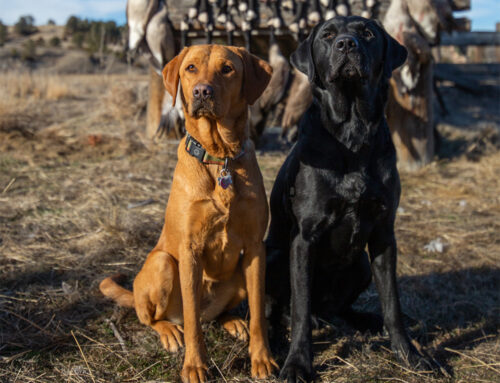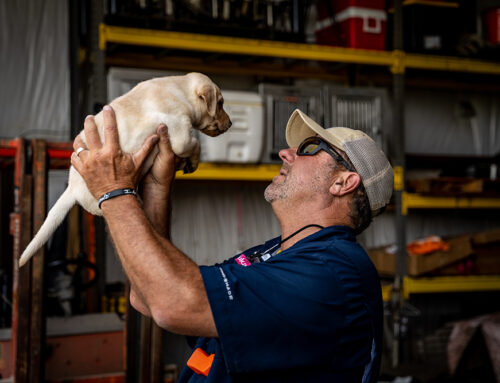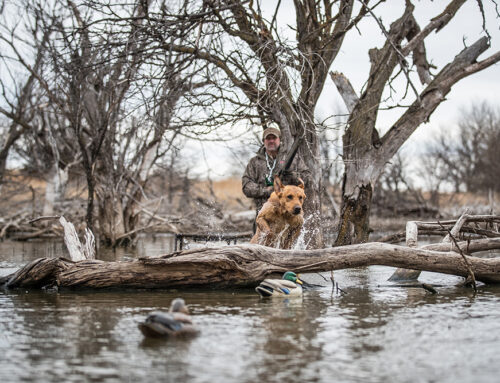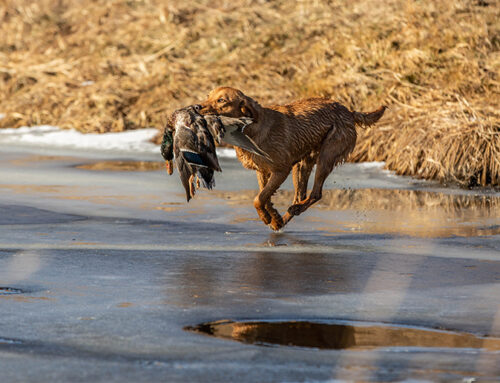The Little Brown Duck Dog

By Paul Wait
Like many small-town doctors of his day, Fred J. Pfeifer was a prominent, revered man in the Wisconsin city where he practiced medicine. By all accounts, he was a fine physician. But his place in history has little to do with saving people.
Instead, Dr. Pfeifer is best remembered as the Wisconsin man who “gave birth” to a breed of small brown hunting dogs in the early 1900s.
 According to an article written by Pfeifer in the March 1926 issue of Dog World magazine, the American water spaniel was originally a mix of the English curly-coated retriever and the field spaniel. They were bred to be duck skiff dogs, yet be able to hunt upland game, too.
According to an article written by Pfeifer in the March 1926 issue of Dog World magazine, the American water spaniel was originally a mix of the English curly-coated retriever and the field spaniel. They were bred to be duck skiff dogs, yet be able to hunt upland game, too.
“Our dogs have brown eyes, are brown with a thick, short curly coat, medium in size, and weigh about 35 to 40 pounds,” Pfeifer wrote. “They are small enough to tuck away in a canoe or auto, yet hardy and strong enough to endure icy water and combat against tall grasses and rice in the marshes.”
Pfeifer owned Wolf River Kennels in New London, Wisconsin, and reportedly had 132 American water spaniels there at one time in the 1920s. He truly championed the breed, and many local duck hunters found them to be excellent working dogs.
“For the past few years we have offered to return the purchase price of a pup should he not prove satisfactory both in the home or in the field,” he wrote. “As yet we’ve not been required to make good for one of the pups.”
The good doctor also petitioned the United Kennel Club to recognize the breed, and on Feb. 8, 1920, “Curly Pfeifer” became the first registered American water spaniel. The American Kennel Club officially recognized the American water spaniel in 1940.
Battle for Statehood
After decades in relative obscurity, American water spaniels entered the limelight again in 1981 when Lyle Brumm, an 8th-grade teacher in New London, encouraged his students to draft a bill to learn about the legislative process. Brumm’s class decided to push for a big honor: They wanted the American water spaniel to officially become Wisconsin’s state dog.
Their bill met shocking resistance in the political arena.
The bill died in committee after a hearing attended by Brumm’s students, where “committee members greeted them with howls, barks and insults,” according to a 2007 article published in AKC Family Dog. One state senator who opposed the bill called the breed “flea-bitten mangy mutts.”
Undeterred, Brumm took the case to the press. Radio interviews, hundreds of letters, visits to the state capitol of Madison and even a scathing editorial in The New York Times kept the pressure on Wisconsin lawmakers.
When Wisconsin Gov. Anthony Earl visited New London in 1984, about 500 students demanded action. As a goodwill gesture, the governor promised to return to sign the bill if they could get it passed.
After more campaigning, letters and another legislative committee hearing in March 1985, the bill finally passed. On April 22, 1985, with an American water spaniel perched on a table next to him and 1,000 New London students watching, Gov. Earl signed the law designating the breed as Wisconsin’s state dog.
Dedicated to the Breed
Despite the fanfare, the American water spaniel is a rare breed. Only about 3,000 are believed to exist.
 The American Water Spaniel Club was formed in 1985 to promote and celebrate the breed. The club sponsors national specialties and hunt tests during its annual gathering, which this year was held in Clintonville, Wisconsin.
The American Water Spaniel Club was formed in 1985 to promote and celebrate the breed. The club sponsors national specialties and hunt tests during its annual gathering, which this year was held in Clintonville, Wisconsin.
American water spaniels are most commonly found in Wisconsin and Minnesota, but they certainly have taken root elsewhere. Lois McCracken of Wedgefield, South Carolina, brought two of her dogs to the Wisconsin gathering. She’s a breeder, and proudly proclaimed that her dogs have been Hunting Retriever Club champions, earned Master Hunter titles, been decorated show dogs and function as great therapy dogs.
“American water spaniels are the right-sized dogs to have in hunting boats, and they’re great family dogs,” she said as she lovingly scooped water over Bea, her 3-year-old dog that had just competed in a “roustabout” field shoot.
Rob Goodman of Phelps, New York, brought Logan, his 5-year-old dog and third American water spaniel, to Wisconsin. He hunts waterfowl on Lake Ontario, and prefers to have a smaller dog in the duck boat.
“I do a lot of upland hunting, too, and they can go from waterfowling to upland hunting and not miss a beat,” Goodman said.
Tim Otto, of Antigo, Wisconsin, brought Aldo, his 2-year-old, to the hunt test. A first-time American water spaniel owner, Otto hunts beaver ponds for ducks, but also pursues ruffed grouse and pheasants.
“Some people say American water spaniels are better at hunting upland game; some people say they’re better at waterfowl hunting,” Otto said. “They’re not for everyone. They can be a little sassy, and you have to be patient with them.”
So how did he settle on getting an American water spaniel?
“I researched different breeds when I was considering getting a duck dog,” Otto explained. “I’m a big Wisconsin history buff. I like the Packers, brats, cheese and waterfowl hunting. So, I thought I should have an American water spaniel.”
Paul Wait is editor and publisher of Delta Waterfowl.






Have had two in my life, both great dogs and loyal companions. The first one(Lindy) was my childhood companion (1946–1958) the second Loo (1979-1989)
If I have another dog it would be an American Water Spaniel.
Michael Kiger
Often times my Boykin Spaniel is confused with the American Water Spaniel. It is easy to see why. My buddies tease me about it. But you know what? I never met a dog I didn’t like. They are great company.
Terry Enright
Suamico Wi.
I have my first aws, nice dog, I do believe he’s a better field dog than a water dog. But he does retrieve ducks also.
I have my 2nd AWS named Rosie and she demonstrates all the attributes mentioned above. A great family companion, robust hunter, and guardian of our acreage!